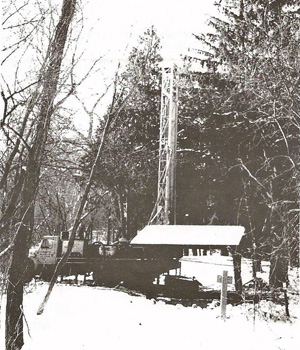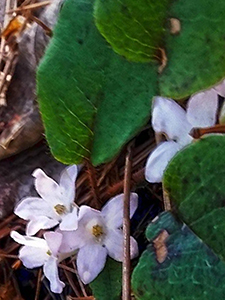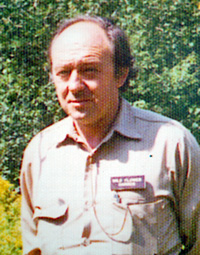Friends of the Wildflower Garden
A web of present and past events

These short articles are written to highlight connections of the plants, history and lore of the Eloise Butler Wildflower Garden with different time frames or outside connections. A web of intersections.
Signs of spring - pussy willow catkins are emerging. Then we look at some historical events. The continuing decline of the monarch butterfly population has been documented again this winter. A last ditch effort to save the Great Medicine Spring was made 25 years ago, while 100 years ago Eloise Butler and the Wild Flower Preservation Society brought public attention to wild flowers. Then a look back when winter days were cold and South Wirth was quiet.
This Month
Another decrease in winter monarchs
The last days of the Great Medicine Spring
Eloise Butler and early attempts to protect wildflowers
1974 - the end of peaceful winters in South Wirth
Pussy Willow now showing signs of spring
Another decrease in wintering monarchs
Recent news headlines have run something like this:
Eastern migratory monarch butterfly populations decrease by 59% in 2024
It does read like something heard once before, doesn’t it? Indeed, the chart below shows that the trend of the last 30 years is a downward slope in population of the Eastern Monarch Population which is the set that populates North America from the great plains eastward and winters in the Neovolcanic Range of central Mexico. This winter’s estimate is that the monarchs occupied only 2.2 acres, 59% less than the previous winter.

This survey is taken annually by the World Wildlife Fund. A quote from their latest report:
This season's largest colonies were detected outside the Monarch Butterfly Biosphere Reserve, with 0.84 acres in the Palomas sanctuary, and 0.5 acres in the Peña Ahumada sanctuary, both in the State of Mexico. In El Rosario, in the Sierra Campanario sanctuary, Michoacán, where the largest colony is traditionally located, the butterflies occupied an area of 0.46 acres. Data recorded in 2023-2024 represents the second-smallest area occupied by monarch butterfly colonies in Mexico since 1993, when population monitoring began, only preceded by the 1.7 acres observed in 2013-2014. The largest recorded population was in 1996-1997, with 45 acres monitored.
Below: Monarchs of the eastern population in refuge in Mexico. Photo: Count Whelan Photography.

For more documentation of the eastern population winter reports use this link: Monarch Joint Venture.
The Western migratory monarch population is not faring much better. This group migrates in summer to the area of the Rocky Mountains and westward, then winters in many sites along the coastline of California and Baja California. This group also had the largest population 30 years ago, then dropped off precipitously and then held somewhat steady for many years until another plunge in 2018, followed by some recovery in 2021 and 2022, with enthusiasts rejoicing, only to see another decline this winter.
Below: A group of the western monarchs in refuge.

For more on the western population reports go to this link: Monarch Joint Venture Blog
For a description of the differences between the eastern and western monarch populations, read this study from Conservation Science and Practice (PDF).
The last days of the Great Medicine Spring

The Great Medicine Spring became part of the history of the Friends of the Wildflower Garden 25 years ago when the Friends agreed to fund one last attempt to save the spring by installing a new well to try to reactivate the water flow. Over the prior 3 decades the spring had flowed in bits and starts and following the start of construction of Interstate 394, the flow of the old spring had gradually dropped to a trickle after 1987.
Twenty-five years ago during the winter of 1998-99 the Friends contracted with Renner Well Drilling to drill a deep well for a hand pump at the site of the ancient Great Medicine Spring just outside fence of the Garden. In January 1999 the drilling reached an area at 135 feet depth that produced a large free flow of water such that a faucet needed to be installed. The expectation was that in the spring, visitors could once again enjoy free flowing spring water. However, over the next several years, even after a hand pump was installed, the water source that had been tapped ran out and public access was discouraged.
The tornado of 2011 devastated the area around the spring and it remains in that state today. In 2014 the pump handle was removed to prevent people from pumping water that was now contaminated and the entire well area was removed in 2018. Today all that remains is the old limestone catchment basin - a far cry from the impressive spring head construction build around the spring in 1939.
Below: The new canopy over the new fountain on the Great Medicine Spring. Canopy built by Park Board carpenters and installed after the WPA masonry crew finished the fountain in 1939. Photo by Walter Dalhberg, 1939.

Below: The catch basin and pump of the Great Medicine Spring, not functional, as seen in 2008. Photo G D Bebeau



You can read all the detailed history of the spring with before and after photos, and of the other three springs around the Wildflower Garden in this article.
Eloise Butler and the early attempts to protect wild flowers.
A 1907 newspaper reporter wrote: “There was a time, and not so long ago, that some Minneapolis families could pluck these rare wild flowers almost from their back doors, but when too many people took a hand in the culling and the plucking became a massacre, the plants grew discouraged and disappeared.” Something had to be saved. (pdf copy)

One hundred years ago, during the week of April 21 - 25, 1924 the Minnesota Chapter of the Wild Flower Preservation Society of America put on a wild flower display in the corner window of Donaldson’s Department Store in downtown Minneapolis. Eloise Butler was a member of the Chapter and chairman of the membership and publicity committee. Naturally, as curator of the wild flower garden in Glenwood Park, she supplied the wild flowers.
The vice president of this Minnesota Chapter was Dr. C.O. Rosendahl of the University of Minnesota, Chairman of the Department of Botany. It had been 17 years since the founding of the Wild Flower Garden in 1907 when Rosendahl was one of the signers of the petition to create the Wild Flower Garden. Later in 1932 he turned down a request by Eloise to help with the maintenance of the Wild Flower Garden.

The State Society was pushing for laws prohibiting the picking of certain wild flowers from the wild and that was the theme of the show. At that time it was “free pick’en” where ever you found them. It took many years for that law to be passed. There was concern of course, for the state flower, the Showy Lady’s-slipper, and picking that was prohibited in 1925 but it was not until the 1971 legislative session that other wild flowers were protected and that was done via the establishment of the state’s endangered and threatened species act.
The first paragraph of that act states:
Subdivision 1.Restrictions on collecting. No entity shall distribute any species of orchids (Orchidaceae), any gentian (Gentiana), arbutus (Epigaea repens), lilies (Lilium species), coneflowers (Echinacea species), bloodroot (Sanguinaria canadensis), mayapple (Podophyllum peltatutum), any species of trillium (Trillium species), or lotus (Nelumbo lutea), that have been collected in any manner from any public or private property without the written permission of the property owner. Plants listed in this subdivision that are intended to be offered for sale must have written authorization from the commissioner.


There are additional details in the law which you can read on this website link.
The end of peaceful winters in South Wirth
A look back 50 years when winters were cold, with snow and south Wirth was undiscovered - by a reporter of those days.

Today, January 1, 1974, as I write this it is -30°. We have broken the record for low readings three days in a row and it is supposed to be cold again tomorrow. Last Sunday when it was about 0, my wife and I went to the Garden to fill the bird feeders. Since it was so cold we parked at the south end, rather than at the Spring, to make a quick trip of it. One car was parked at the gate when we arrived there. As we left our car another car pulled up with two young men with skis. When we left, just thirty minutes later, there were four other cars in the parking spot. At the top of the hill there was a family skiing; while I was filling the feeder some skiers went by; we met two skiers at the back of the Garden, two skiers coming down the hill from the hayfield, and two more skiers as we left the hayfield. (Skiers seem to run in packs of two.) I can't help but compare this with the first few years that I had the Garden. In those days you could spend hours in the park during the winter and never meet anyone. Starting about 1965 a few people started discovering how beautiful the Park was in the winter and with the rise in popularity of Cross-Country Skiing in the last few years, the winter seclusion of the area has almost vanished.
Reported by Garden Curator/Gardener Ken Avery in the Friends newsletter, (Vol. 22 No.1 Jan 1974) PDF
Pussy Willows now show signs of spring.
It is mid-February and we are seeing our first signs of spring. The pussy willows (Salix discolor) are already breaking open their flower buds. The fine silvery hairs, particularly of the male catkins, are already pushing away the single reddish-purple scale that covers them.

Eloise Butler said the flowers were “showing off their warm fur coats.” It is these fur coats that keep the reproductive parts warm during the early days of spring. Only after it is warm enough will the actually flowers fully develop.
In the willow species, the male and female flowers are in separate catkins on different plants (plants are said to be “dioecious”). The male flowers open a bit before the female and are distinguished by the intense yellow color of their pollen on their anthers. The female flowers are a light green with yellow styles.


One issue this year with this early warm spell is whether there will be enough early emerged bees and flies to pollinate the flowers. Unlike many dioecious plants, the pussy willow does not wind pollinate, it requires an insect. Both sexes have a nectar gland at the base of the flower, which gives off a honey-like aroma to temp insects. We shall see if any seed is set this year.
Fortunately we still have in our metro area a number of marshes and wetlands where these shrubs can grow in full sun ands moist soils; but much less so that 100 years ago. When the Wildflower Garden was founded the pussy willow was one of the 10 must common shrubs.
Read our pussy willow fact sheet here.
Photo Note
Photos that are credited with a "CC " caption are used under Creative Commons license for educational purposes. The letters and numbers, such as "CC-BY-SA 3.0" refer to the license type. These photos may be used by others only for free educational purposes so long as credit is given to the original author whose name precedes the license type. You may learn all about the requirements on the Creative Commons webpage.
Previous articles
January 2024 - 100 Years of Bird Banding
January 2024 - The Dutchman's Pipe
January 2024 - A re-discovered area in Wirth Park
January 2024 - New Winter Activities with Garden Naturalists.
December 2023 Curiosity About a Plant Name
December 2023 Are Honeycombs as Perfect as They Look?
December 2023 Why do Icicles Have Their Shape?
December 2023 Eloise's Issues with White Oaks
December 2023 Monarch Threatened with Fiery Death
November 2023 - The ESA at Fifty
November 2023 - Do Plants Hear?
November 2023 - Eloise Talks to Plants
November 2023 - The Rarer Rubus Compared
All selections published in 2024
All selections published in 2023